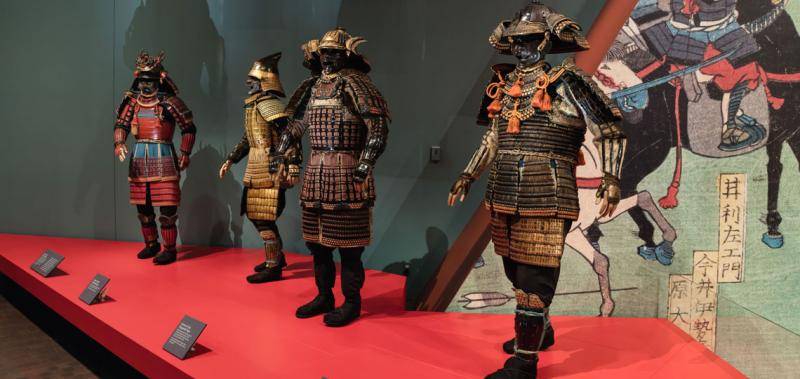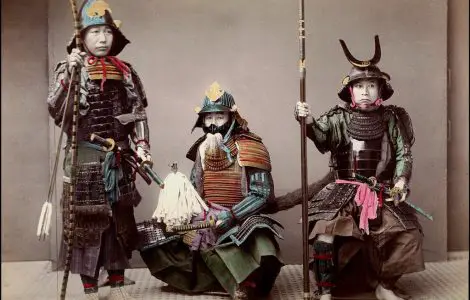Explain Three Different Aspects of Samurai Training
Finally it is a mans obligation to teach his children moral standards through the model of his own behavior. To the samurai loyalty to superiors was never questioned.

Yoair Blog The World S Anthropology Blog Publication
Section 6-Training in Writing and literature.

. Samurai practiced calligraphy and wrote poetry. Over its long history it has put a large emphasis on virtue in battle. When they entered their rank of either knight or samurai.
Three of the most influential leaders of the new JapanInoue Kaoru Ito Hirobumi and Yamagata Aritomohad studied with the famous samurai Yoshida Shouin who was. Many of the sections contain parallel presentations on the US. One might think that bushido would fade away along with the samurai who had invented it.
They studied the tea ceremony which fostered a spirit of harmony reverence and calm and practiced Buddhism which taught discipline and focus. Regional constables called daimyo developed considerable power and meddled with the shogunates line of succession. Section 7-Training for the Tea Ceremony.
There was no place for fear in the way of the warrior and this conduct of self discipline and respectful ethical behaviour was to become the role. Emerging from provincial warrior bands the samurai of the Kamakura. They also studied subjects such as calligraphy literature and flower arranging.
The Kemmu Restoration of imperial power lasted only three years. Samurai recruits training for the Satsuma Rebellion. This unique philosophy valued honour reckless bravery and selflessness as well as duty to the warriors master with the purpose of giving up ones life and embracing death.
Tradition and honor played a major role in the life of a Samurai warrior. Ancient Japanese Samurai Training Methods Mental Preparation. Training delivery not only helps trainees learn faster it can also help them understand what they are expected to do after they have completed their training.
Different aspects of the Samurai. The two great skills of the Samurai members of the warrior caste that ruled Japan for 300 years until 1867 were swordsmanship and calligraphy. They were however just one of numerous different types of warrior distinct to that period.
Chapter 22 The Rise of the Warrior Class in Japan HW 524. Japanese culture was evident in samurai training in the study of writing and literature tea ceremony and Buddhism. Like the knights of feudal Europe they were the expensively equipped warrior aristocracy.
Samurai warriors were physically prepared for battle by training under masters. They learned fencing horseback riding and martial arts. Responsibilities of samurai include but are not limited to keeping the daimyo and his family safe protecting the daimyos land castle and property maintaining weapons and armor and always adhering to BushidoThe task of your students is to assume the role of.
In 1336 the Ashikaga shogunate under Ashikaga Takauji reasserted samurai rule though this new shogunate was weaker than that of the Kamakura. Section 4-Military Training and Fighting. Samurai Ninja Ronin And More Seven Different Warrior Classes Of Feudal Japan.
E Be prepared to explain your three examples to others in your group. To be truly courageous means to face your life as a whole with the confidence necessary to overcome your challenges and realize happiness. The term samurai was originally used to denote the aristocratic warriors bushi but it came to apply to all the members of the warrior class that rose to power in the 12th century and dominated the Japanese government until the Meiji Restoration in 1868.
Japanese culture goes back thousands of years. After the samurai ruling class was abolished in the wake of the Meiji Restoration Japan created a modern conscript army. By passing money through complex transfers and transactions or through a series of businesses the money is cleaned of its illegitimate origin and made to appear as legitimate business profits.
Form Function The What How and Why of Samurai Armor Examining a Kawari Kabuto A Warriors Duty. So if your organization is looking for effective training delivery methods for its personnel then the three. Gross Profit Gross profit is the.
Feudal Japan is remembered as the era of the samurai. Its no surprise that a warrior must be courageous but courage is about more than just the courage to face your own death in combat. To accomplish all the requirements See evaluation.
Centuries before the advent of health clubs and charity ultra-marathons samurai conditioned. The Task You will need to focus on three basic aspects and find the answers for the given questions. Resources All components of the Black Ships Samurai unit contain information that can benefit your group.
Intellectual superiority was esteemed but a samurai was essentially a man of action. Their Shinto gods established the order when they created the world but Confucius articulated how the Japanese should view their shoguns daimyos and samurai. Section 3-The Samurais Armor and Weapons.
Views and the Japanese views of a particular topic. Three Lions Hulton Archive Getty Images Modern Bushido. Poetry rock gardens monochrome ink paintings and the tea ceremony were common aspects of samurai culture.
They prepared mentally by learning how to endure pain and suffering and developing a sixth sense about danger. The subtler faculties of prudence intelligence and dialectics were less important. Samurai would have made excellent Gryffindor.
Prepared from a very young age samurai and knights were trained in many aspects such as combat strategy serving a lord and honor above all else. Money laundering is a process that criminals use in an attempt to hide the illegal source of their income. The samurai enthusiastically embraced Confucian ideals due to the advocacy of what they believed was the natural hierarchy of man.
In order to do this your group must work efficiently in order. The basis of samurai conduct is bushido the way of the warrior. Different training delivery methods offer different benefits to organizations.
Much of the samurais legendary discipline derives from the observation of Bushido a code of. A Japanese warrior unlike in other parts of the globe has to be full of virtue to be honorableThe word bushido refers to exactly that and in English it means the way of the warrior. Samurai member of the Japanese warrior caste.
The Art of Calligraphy Writing a Waka Written and Visual Samurai Narratives Religion in Japan. The first objective of samurai education was to build up Character. Section 2-The Rise of the Samurai.
3 bring your class to the museum you may find this 7 Section 2.

The 3 Unifiers Of Japan Denver Art Museum


Belum ada Komentar untuk "Explain Three Different Aspects of Samurai Training"
Posting Komentar